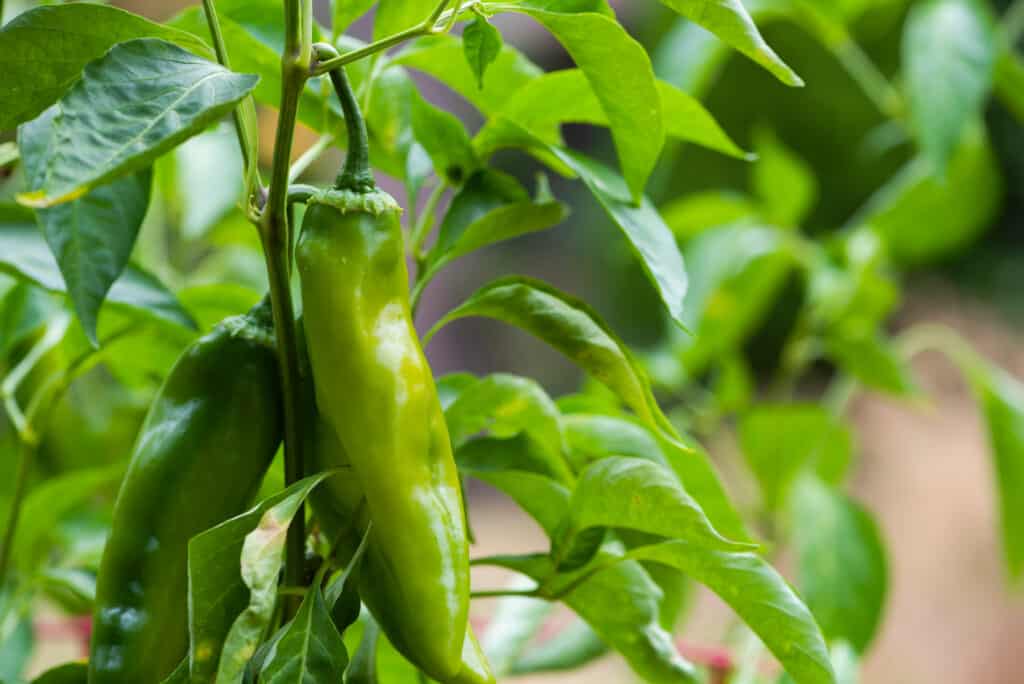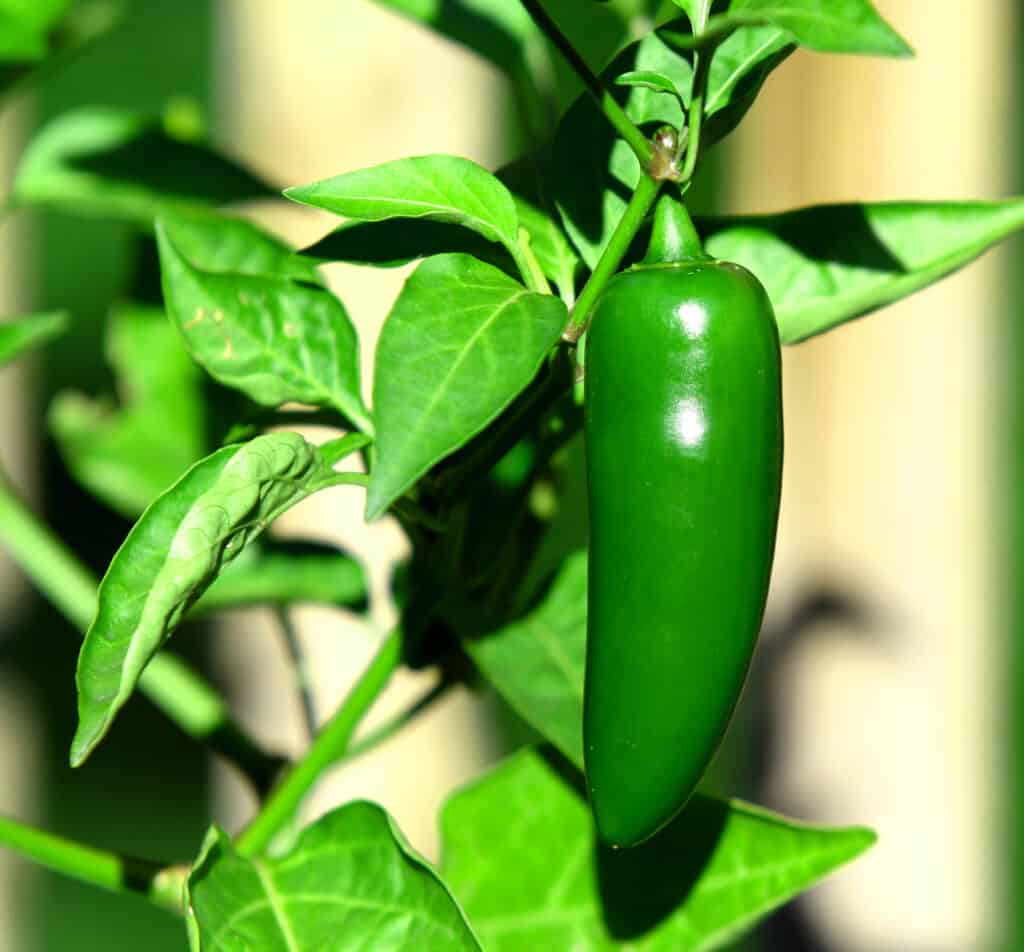If you enjoy chili peppers, you probably know there are many varieties with unique physical characteristics and tastes. All over the world, people enjoy chilis in various dishes, as spices, and as ornamental plants that brighten up their gardens.
But in the wonderful world of chili peppers, it’s important to know the differences between varieties. No one wants to bite into what they expect to be a mild, mostly sweet chili pepper only to realize far too late that their tongue is on fire.
Thankfully, with a little bit of knowledge, you can competently tell the difference between chili pepper varieties. In this guide, we’ll compare the Anaheim pepper vs. jalapeño to identify where they overlap and what distinguishes one from another.
We’ll be covering botanical classifications, physical descriptions, culinary uses, origins, and growing tips.
So, pepper lovers get ready, ’cause we’re jumping in!
Anaheim Pepper vs. Jalapeño: A Quick Look
| Anaheim Pepper | Jalapeño Pepper | |
|---|---|---|
| Plant Classification | Scientific Name: Capsicum annuum ‘Anaheim’ | Scientific Name: Capsicum annuum ‘Jalapeño’ |
| Plant Description | Perennial plant that produces mild, medium-sized chili peppers. Pepper grows to about 6-10 inches in length. The plant grows to 18-24 inches tall. | Perennial plant that produces moderately hot, small chili peppers. Pepper grows to about 3-5 inches in length. The plant grows to 24-36 inches tall. |
| Culinary Uses | Favored for use in roasting and stuffing. A mild pepper particularly enjoyed in salads and salsas. Also commonly dried and used as a spice. | Favored for use in hot salsas, appetizers, savory bakes, and as pickles. Mildly to moderately hot. Gain in sweetness as they mature. |
| Nutritional Facts and Medicinal Uses | Particularly high in vitamins C and A. Contain lycopene when red. | High in vitamin C. Contain lycopene when red. |
| Origin | Originated in New Mexico, USA. Cultivation spread to Anaheim, California in the early 1900s by farmer named Emilio Ortega. | Originated in Veracruz, Mexico. Named after Xalapa, the capital city of Veracruz. |
| Harvesting | 75-80 days to reach ripeness during green stage. 100 days to reach red color. | 75 to 80 days to reach ripeness during green stage. About 90 days to reach red color. |
Plant Classification
Anaheim and jalapeño peppers are varieties of the same genus and species, Capsicum annuum. This genus of peppers is commonly known as chili peppers, which are widely used around the world as ornamentals and for culinary purposes.
Both Anaheim and jalapeño peppers belong to the Solanaceae family, which includes other common fruits such as bell peppers, banana peppers, tomatoes, tomatillos, and eggplants.
If you’re wondering why we call the above-mentioned foods fruits, it’s because botanically speaking, they are fruits since they contain seeds. A true example of a vegetable is asparagus as it is an edible part of the plant that does not contain the plant’s seeds.
Anaheim Pepper vs. Jalapeño: Plant Description
These plants may look similar, but Anaheim and jalapeño pepper plants have a couple of key physical differences that can help you distinguish them from each other. In terms of growth, Anaheim pepper plants tend to reach a shorter height than jalapeño plants. Expect Anaheim pepper plants to reach a height of about 18-24 inches, whereas jalapeño plants tend to grow to a height of about 2 to 3 feet.
By far, the easiest way to distinguish these plants is to compare them during fruiting. Jalapeños are much smaller at maturity than Anaheim peppers, reaching a length of about 3-5 inches in length. They have a less curved shape than Anaheim peppers and no noticeable wrinkles. When ripe, these peppers also tend to develop coarse white marks on the skin.
Conversely, Anaheim peppers mature at lengths of 6-10 inches long and have a much more curved shape. The skin of the pepper is less smooth with wrinkling and indents along the centerline of the fruit. Anaheim peppers also tend to feel less firm and more pliable than jalapeños.

Jalapeños are much smaller at maturity than Anaheim peppers with a less curved shape and no noticeable wrinkles.
©iStock.com/hongquang09
Culinary Uses
Both peppers are commonly used in South American, Central, Mexican, and Southwest American dishes. However, through trade, travel, and colonization, jalapeño peppers are now common ingredients in dishes around the world. For instance, pickled jalapeño peppers are used in several Vietnamese dishes such as pho and bahn mi sandwiches.
Since they’re not overwhelmingly hot, both peppers are often used for stuffed pepper recipes. Stuffed jalapeño poppers are a common bar appetizer which features baked, breaded jalapeños stuffed with cheese. As larger peppers with a milder flavor profile, people often use stuffed Anaheims as a main dish. An example of such a dish is baked Anaheim peppers stuffed with rice, chicken, and cheese, which is commonly enjoyed in Mexico and across the US.
In terms of taste, Anaheim and jalapeño peppers are easily distinguished. The taste profile of jalapeños is often described as fresh, crisp, mild to moderately hot, and grassy. Once it turns red, many people describe a sweet note mingling with the heat. When pickled, jalapeno peppers taste less hot and are more suitable for people with milder palates. Anaheim peppers are notably milder than jalapeños, and people typically describe a slightly fruity, mellow flavor.

As larger peppers with a milder flavor profile, people often use stuffed Anaheims as a main dish.
©SaraJane / Flickr – License
Anaheim Pepper vs. Jalapeño: Origins
Botanists have pinpointed the origins of chili peppers to South America, with many further pinpointing the birthplace to a mountainous region of Brazil and Bolivia. Indigenous peoples of these regions have likely cultivated chili peppers for at least 7,000 years.
From South America, chili peppers spread and many varieties, including Anaheim and jalapeño, have since originated around the world.
The Anaheim pepper originated in New Mexico, where it is commonly called the New Mexico pepper, or simply “chile” due to how widely available and used it is in homes, stores, and restaurants. This chili pepper became commonly known as the Anaheim pepper after a farmer by the name of Emilio Ortego brought seeds back from New Mexico to his hometown of Anaheim, California in the early 1900s. From there, the popularity and cultivation of the Anaheim pepper spread.
The jalapeño pepper originated in the Mexican state of Veracruz. Spanish settlers in the 17th century named the pepper jalapeño, meaning “of Xalapa” (or Jalapa), after the capital city of Veracruz, Xalapa. From Xalapa, this moderately hot little chili pepper has become a staple ingredient in dishes across the globe.

The Anaheim pepper originated in New Mexico, known as the New Mexico pepper, or simply “chile” due to how widely available it has become.
©Michaela Warthen/Shutterstock.com
Nutritional Facts
Both Anaheim and jalapeño peppers are high in vitamins C and A, and when allowed to ripen to a red color, contain lycopene. Lycopene is a beneficial heart-protecting antioxidant. About 75 grams of Anaheim peppers contain 219% of the daily recommended vitamin C intake and 111% of vitamin A. A 100-gram serving of jalapeño peppers contains 66% of the daily recommended vitamin C intake.
Harvesting and Plant Care Tips
As a part of the same genus and species (Capsicum annuum), Anaheim and jalapeño peppers have similar growing requirements and preferences. They both prefer to grow in at least six hours of direct sunlight and are hardy in USDA growing Zones 5-11.
Anaheim pepper plants thrive in light, well-draining soil that is slightly acidic to neutral (5.5-7 pH). Typically, these peppers take about 75 days to reach a harvestable ripeness. If you want to harvest them when they’re red, you’ll need to wait about 100 days.
Similar to Anaheims, jalapeño pepper plants prefer light, sandy-loamy well-draining soil. Although, they prefer soil with a neutral pH. Jalapeños also take about 75 days to reach maturity, but they turn red a bit faster than Anaheim peppers at 90 days.

The jalapeño plant reaches 24-36 inches in height and its peppers grow to 3-5 inches in length.
©iStock.com/Victor Ward
Up Next:
- Cayenne Pepper vs. Red Pepper: Is There a Difference?
- Habanero Pepper vs. Jalapeño
- Serrano Pepper vs. Jalapeño: What Are The Differences?
The photo featured at the top of this post is © Zachary C Person/Shutterstock.com
Sources
- North Carolina Extension Gardner Plant Toolbox, Available here: https://plants.ces.ncsu.edu/plants/capsicum-annuum/
- The National Gardening Association, Available here: https://garden.org/plants/view/125991/Pepper-Capsicum-annuum-Anaheim/
- The National Gardening Association, Available here: https://garden.org/plants/view/87691/Jalapeno-Pepper-Capsicum-annuum-Jalapeno/
- PepperScale, Available here: https://www.pepperscale.com/anaheim-pepper-nutrition/
- The Food Source Information Wiki , Available here: https://fsi.colostate.edu/jalapeno-peppers/
- Growing Chillies, Available here: https://growingchillies.net/anaheim-chili-peppers-and-how-to-grow/
Thank you for reading! Have some feedback for us? Contact the AZ Animals editorial team.






